Thessaloniki
 Thessaloniki is the second largest city of Greece and the capital city of the region of Macedonia. Throughout history, the city enjoyed the advantages of its strategic location. The famous Via Egnatia (Egnatian Way), spanning Macedonia from east to west, passed through the walls of the city. This important Roman highway facilitated travel and commerce between Rome and her eastern provinces. It has been estimated that during Paul's time its population may have been as high as 200,000. The majority of the inhabitants were Greeks, but there was also a mixture of other ethnic groups, including Jews. Thessaloniki was founded by Kassandros, King of Macedonia in 315 BC. The city is named after his wife, Alexander the Great's sister. It became the capital of the Roman province of Macedonia in 148 BC and an important harbour. At about 300 AD, tetrarch Galerius Maximianus transferred the capital of his province to Thessaloniki, and had a series of new buildings constructed. Thessaloniki is the second largest city of Greece and the capital city of the region of Macedonia. Throughout history, the city enjoyed the advantages of its strategic location. The famous Via Egnatia (Egnatian Way), spanning Macedonia from east to west, passed through the walls of the city. This important Roman highway facilitated travel and commerce between Rome and her eastern provinces. It has been estimated that during Paul's time its population may have been as high as 200,000. The majority of the inhabitants were Greeks, but there was also a mixture of other ethnic groups, including Jews. Thessaloniki was founded by Kassandros, King of Macedonia in 315 BC. The city is named after his wife, Alexander the Great's sister. It became the capital of the Roman province of Macedonia in 148 BC and an important harbour. At about 300 AD, tetrarch Galerius Maximianus transferred the capital of his province to Thessaloniki, and had a series of new buildings constructed.
Thessaloniki is a modern industrial port, partly protected by impressive city walls. There is a large Archeological Museum, housing the "Treasures of Ancient Macedonia". On the seafront, there is the 16th-century White Tower, built by the Ottomans as part of the city's defence system. The main ancient sites are the Arch of Galerius, built in 297 AD, and the ruins of the Roman Forum (Agora).
From any place in Halkidiki there is a regular bus service to Thessaloniki almost every hour. The trip usually takes about an hour and a half with stops in every village on Kassandra. The bus terminal of Halkidiki is not very close to the centre of the city, so do catch a bus or a taxi to the centre.
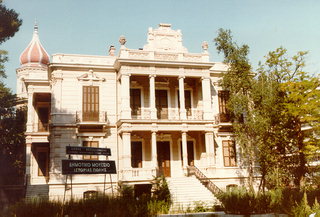 The first impression of Thessaloniki might not be so good. For instance, as you walk along the Vassilissis Olgas Street, you will meet the art-nouveau villas built by the rich Jews at the turn of the century (Villa Modiano at No.68, Villa Casa Bianca and Villa Mordoh at No.162 are the most characteristic), but they are all swallowed by the huge flat-roofed expressionless apartment buildings, so sometimes you don't even notice them. Villa Modiano is very nicely restored and today the ethnological museum is located there. You can stop for a short rest at the small park with a statue of Alexander the Great as you approach the city centre. The first impression of Thessaloniki might not be so good. For instance, as you walk along the Vassilissis Olgas Street, you will meet the art-nouveau villas built by the rich Jews at the turn of the century (Villa Modiano at No.68, Villa Casa Bianca and Villa Mordoh at No.162 are the most characteristic), but they are all swallowed by the huge flat-roofed expressionless apartment buildings, so sometimes you don't even notice them. Villa Modiano is very nicely restored and today the ethnological museum is located there. You can stop for a short rest at the small park with a statue of Alexander the Great as you approach the city centre.
If you want to ask for information, the office of the Greek National Tourist Organization (GNTO) is on Aristotelous Square, so take Nikis Str. along the sea to reach it. From one side you have a sea promenade and from the other the same ugly apartment buildings which all seem to have cafés on the ground floor. All these cafés look very appealing and they are a good place to go out at any time of the day.
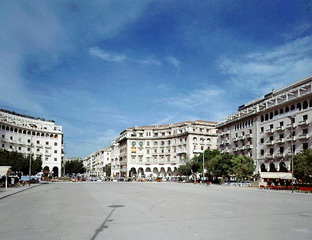 Aristotelous Square is a very nice place. It is huge, with much nicer buildings, all with a very nice ongoing facade which give the square an impression of a lovely whole. Pigeons are flying around and again cafés packed with people line the square. The service is great in these cafés, they make great coffee, they always serve water with no matter what you order plus you get snacks, like chips or peanuts, if you order soft or alcoholic drink, or cookies if you order coffee. Afterwards, they say "Enjoy your drinks" and they disappear and you won't feel they are there. Just remember if you want to order normal coffee you ask for frappé and if you want turkish coffee you ask for greek coffee. Aristotelous Square is a very nice place. It is huge, with much nicer buildings, all with a very nice ongoing facade which give the square an impression of a lovely whole. Pigeons are flying around and again cafés packed with people line the square. The service is great in these cafés, they make great coffee, they always serve water with no matter what you order plus you get snacks, like chips or peanuts, if you order soft or alcoholic drink, or cookies if you order coffee. Afterwards, they say "Enjoy your drinks" and they disappear and you won't feel they are there. Just remember if you want to order normal coffee you ask for frappé and if you want turkish coffee you ask for greek coffee.
We feel we have to repeat that the first impression of the city might be somewhat chaotic. There is a lot of traffic (certainly less than Athens...) and very few seem to follow the traffic rules or lights, neither the drivers nor the pedestrians. Then, wherever you turn, you see the same faceless flat-roofed huge and ugly apartment buildings, and among them drowned and strangled nice 19th and early 20th century houses or hundreds-of-years old churches. There is no respect for them whatsoever. What happened to the imperial city, where is the city of glory that this place once was? You may feel a bit confused in the beginning...
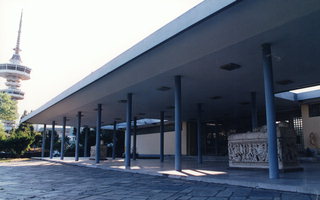 The archeological museum is at the end of Tsimiski Street. The ticket is 4 Euros and a joined ticket for this one and the Byzantine museum costs 6 Euros. This museum is a real gem of Thessaloniki. The first six rooms are dedicated mostly to finds from Hellenistic and Roman times, where you can see sculptures, figurines and glass objects. The highlights are the mosaics from a house in Thessaloniki and elements from the Octagon of the Imperial Palace. In room No.7 reconstructions of the facades of Macedonian tombs are presented. Room No.8 is dedicated to the finds from 121 tombs in Sindos dating from the Archaic and Early Classical periods. The most beautiful and most exciting room of the museum is No.9, which is called "The Gold of Macedonia". If you are in Thessaloniki, this is something you must not miss. You will have the chance to see golden jewellery dating from 6th to 2nd century BC, whose designs look so fashionable and up-to-date even by today's top design standards. The highlight of this room are the golden crowns of the Macedonian aristocrats, inspired by floral motifs, which astonish with their beauty. The archeological museum is at the end of Tsimiski Street. The ticket is 4 Euros and a joined ticket for this one and the Byzantine museum costs 6 Euros. This museum is a real gem of Thessaloniki. The first six rooms are dedicated mostly to finds from Hellenistic and Roman times, where you can see sculptures, figurines and glass objects. The highlights are the mosaics from a house in Thessaloniki and elements from the Octagon of the Imperial Palace. In room No.7 reconstructions of the facades of Macedonian tombs are presented. Room No.8 is dedicated to the finds from 121 tombs in Sindos dating from the Archaic and Early Classical periods. The most beautiful and most exciting room of the museum is No.9, which is called "The Gold of Macedonia". If you are in Thessaloniki, this is something you must not miss. You will have the chance to see golden jewellery dating from 6th to 2nd century BC, whose designs look so fashionable and up-to-date even by today's top design standards. The highlight of this room are the golden crowns of the Macedonian aristocrats, inspired by floral motifs, which astonish with their beauty.
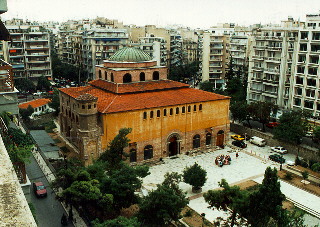 The two most important churches in Thessaloniki are Agia Sofia and Agios Dimitrios. Agia Sofia has a cross-in-square plan with a large dome and was built in the 7th century. Here you can admire some great golden mosaics. The Ascension, with a foreshortened Christ (supported by two angels) is in the central dome and the Virgin Mary with the infant Jesus is above the apse. Here you will also notice a mosaic presenting a cross and stars. This dates from the 8th century Iconoclastic period, when there was a ban on showing the human figure in religious art. Notice the interesting capitals with acanthus leaves supporting the galleries. The two most important churches in Thessaloniki are Agia Sofia and Agios Dimitrios. Agia Sofia has a cross-in-square plan with a large dome and was built in the 7th century. Here you can admire some great golden mosaics. The Ascension, with a foreshortened Christ (supported by two angels) is in the central dome and the Virgin Mary with the infant Jesus is above the apse. Here you will also notice a mosaic presenting a cross and stars. This dates from the 8th century Iconoclastic period, when there was a ban on showing the human figure in religious art. Notice the interesting capitals with acanthus leaves supporting the galleries.
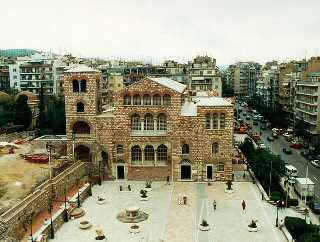 Agios Dimitrios is the most important church in the city. It was built over the roman baths where St. Dimitrios was imprisoned and murdered. It is a great pilgrimage place, since the relics of St Demetrios are still kept in the church in one of the northern naves in a silver casket. The church is a five-aisled basilica and was built for the first time in the middle of the 5th century. Since then it was ruined, rebuilt and renovated many times, and what you can see today is a reconstruction after the great fire of 1917. Unfortunately very little of the splendid mosaics and decorations have survived. There is little left among the big columns of the central nave and some compositions on the western wall of the southern naves and some on the columns of the altar (St Demetrios with two children from 7th century). The early christian capitals of the columns are beautiful, and also notice the funerary monument of Lucas Spandounis from the 1481, on the north-western corner of the main nave. You can also visit the crypt and in the south-eastern corner you can peak in the 14th century chapel dedicated to St. Euthymios. The crypt, which is accessible from a narrow staircase down next to the icon screen, is a very mysterious place. There you will see remains of the roman bath, a roman street, an early christian chapel and a beautiful marble basin in which the miraculous oil that flowed from the saint's tomb was collected. It was a destination for many pilgrims in the past. Agios Dimitrios is the most important church in the city. It was built over the roman baths where St. Dimitrios was imprisoned and murdered. It is a great pilgrimage place, since the relics of St Demetrios are still kept in the church in one of the northern naves in a silver casket. The church is a five-aisled basilica and was built for the first time in the middle of the 5th century. Since then it was ruined, rebuilt and renovated many times, and what you can see today is a reconstruction after the great fire of 1917. Unfortunately very little of the splendid mosaics and decorations have survived. There is little left among the big columns of the central nave and some compositions on the western wall of the southern naves and some on the columns of the altar (St Demetrios with two children from 7th century). The early christian capitals of the columns are beautiful, and also notice the funerary monument of Lucas Spandounis from the 1481, on the north-western corner of the main nave. You can also visit the crypt and in the south-eastern corner you can peak in the 14th century chapel dedicated to St. Euthymios. The crypt, which is accessible from a narrow staircase down next to the icon screen, is a very mysterious place. There you will see remains of the roman bath, a roman street, an early christian chapel and a beautiful marble basin in which the miraculous oil that flowed from the saint's tomb was collected. It was a destination for many pilgrims in the past.
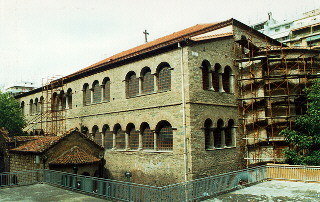 Much nicer than St. Dimtrios is the Panagia Acheiropoietos church. It also dates from the 5th century, but it is a three-nave basilica. The church has survived virtually intact, without many renovations. The "perforated" acanthus leaf decorations on the capitals of the marble columns are impressive. Take also note of the very well preserved early christian mosaics in the arches between the columns showing delicate floral and vine motifs interspersed with birds. This church was also built over roman baths and on some places the beautiful mosaic floor of the baths is still visible. The church is called "the Church of the Virgin Made Without Hands", because it houses the miraculous icon of the Virgin "Panagia Acheiropoietos", which means not made by human hand. You can see the icon on the left from the entrance. Much nicer than St. Dimtrios is the Panagia Acheiropoietos church. It also dates from the 5th century, but it is a three-nave basilica. The church has survived virtually intact, without many renovations. The "perforated" acanthus leaf decorations on the capitals of the marble columns are impressive. Take also note of the very well preserved early christian mosaics in the arches between the columns showing delicate floral and vine motifs interspersed with birds. This church was also built over roman baths and on some places the beautiful mosaic floor of the baths is still visible. The church is called "the Church of the Virgin Made Without Hands", because it houses the miraculous icon of the Virgin "Panagia Acheiropoietos", which means not made by human hand. You can see the icon on the left from the entrance.
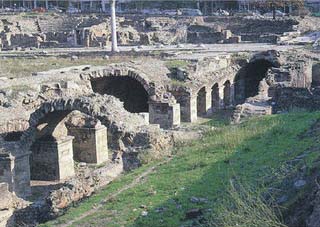 Along the Egnatia Str. you will also find the Bezesten and across the road the Hamza Bey Dzami. The Bezesten is very well preserved. This covered market, with its six domes and four entrances, one on each side, was built in the late 15th century by Sultan Bayezid II. Next on the same street is Panagia Chalkeon church, also known as "The Virgin of the Copper Workers", because of the coppersmith shops that used to exist around it in the past. The church is a very good example of 11th century architecture, with a cross-in-square plan and three domes. From there, you turn uphill to reach the Roman Forum. There is little left of the once huge Roman Forum. In ancient times it was surrounded by stoas and an Odeon used for musical performances (the remains of the Odeon are still visible). Along the Egnatia Str. you will also find the Bezesten and across the road the Hamza Bey Dzami. The Bezesten is very well preserved. This covered market, with its six domes and four entrances, one on each side, was built in the late 15th century by Sultan Bayezid II. Next on the same street is Panagia Chalkeon church, also known as "The Virgin of the Copper Workers", because of the coppersmith shops that used to exist around it in the past. The church is a very good example of 11th century architecture, with a cross-in-square plan and three domes. From there, you turn uphill to reach the Roman Forum. There is little left of the once huge Roman Forum. In ancient times it was surrounded by stoas and an Odeon used for musical performances (the remains of the Odeon are still visible).
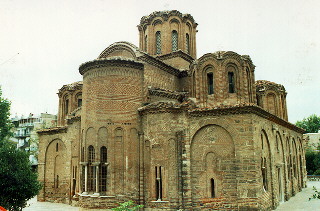 You can easily dedicate a whole day to the Byzantic heritage of the city. You may start from Demokratias Square and follow the city walls. They were first built during Roman times and have been heavily restored since, mostly by the Byzantines 6th to 10th century and during the Ottoman rule. The walls are huge, 10 to 12 meters high, and quite often you will notice remains from other buildings incorporated in them. Soon you will turn in Olympou Street to visit the Holy Apostles Church. This cross-in-square, five domed church was built in the beginning of the 14th century. The church is very beautiful with fine decorations on the outside. Do not miss to enter and see the Transfiguration of Christ mosaic, which even though is very damaged still looks glorious. You continue the walk uphill trying to reach Agia Ekaterini church. The church is very well hidden and you should ask for directions couple of times. After you cross Agiou Dimitrou St., follow Ifestionos Str. to reach Olympiados Str. and start asking for directions here, or get a very good map where the name of the streets will be written also in Greek, otherwise you might get easily lost in the maze of streets in Ano Poli. Agia Ekaterini is again cross-in-square five domed 14th century church with very nice carved marble slabs closing the lower parts of the windows. The fresco decorations inside are very badly damaged and are very hard to follow. Next on Olympiados Str. there is the Prophetes Elias church. Built in the 14th century, this church has a three-conch plan with a big central dome. Almost nothing is left of the inside decorations but note the fine capitals depicting lambs. You can easily dedicate a whole day to the Byzantic heritage of the city. You may start from Demokratias Square and follow the city walls. They were first built during Roman times and have been heavily restored since, mostly by the Byzantines 6th to 10th century and during the Ottoman rule. The walls are huge, 10 to 12 meters high, and quite often you will notice remains from other buildings incorporated in them. Soon you will turn in Olympou Street to visit the Holy Apostles Church. This cross-in-square, five domed church was built in the beginning of the 14th century. The church is very beautiful with fine decorations on the outside. Do not miss to enter and see the Transfiguration of Christ mosaic, which even though is very damaged still looks glorious. You continue the walk uphill trying to reach Agia Ekaterini church. The church is very well hidden and you should ask for directions couple of times. After you cross Agiou Dimitrou St., follow Ifestionos Str. to reach Olympiados Str. and start asking for directions here, or get a very good map where the name of the streets will be written also in Greek, otherwise you might get easily lost in the maze of streets in Ano Poli. Agia Ekaterini is again cross-in-square five domed 14th century church with very nice carved marble slabs closing the lower parts of the windows. The fresco decorations inside are very badly damaged and are very hard to follow. Next on Olympiados Str. there is the Prophetes Elias church. Built in the 14th century, this church has a three-conch plan with a big central dome. Almost nothing is left of the inside decorations but note the fine capitals depicting lambs.
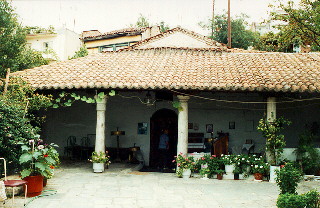 From here you start exploring the maze of streets of Ano Poli (Upper city). It is much more pleasant to walk there. The houses are much smaller, even though you still see the same ugly faceless buildings, but among them you will also have a chance to see some fine 19th century timber houses. It seems that there is a tendency some of these houses to be restored. You again have to ask for directions couple of times if you want to reach the Osios David church. The church is well hidden, just above Romfei Square. Below the square, you can see Byzantine baths which are under restoration. The Osios David church is a small church built in the 5th century and once belonged to the Latomos Monastery. It is most famous for its well preserved 5th century mosaics. There are two compositions preserved: "the Vision of Ezekiel" and "the Baptizing of Christ". The "Vision of Ezekiel" is located in the semi-dome of the apse and it shows Christ (presented as a young man) surrounded by the symbols of the four apostles (angel, eagle, lion and bull). From here you start exploring the maze of streets of Ano Poli (Upper city). It is much more pleasant to walk there. The houses are much smaller, even though you still see the same ugly faceless buildings, but among them you will also have a chance to see some fine 19th century timber houses. It seems that there is a tendency some of these houses to be restored. You again have to ask for directions couple of times if you want to reach the Osios David church. The church is well hidden, just above Romfei Square. Below the square, you can see Byzantine baths which are under restoration. The Osios David church is a small church built in the 5th century and once belonged to the Latomos Monastery. It is most famous for its well preserved 5th century mosaics. There are two compositions preserved: "the Vision of Ezekiel" and "the Baptizing of Christ". The "Vision of Ezekiel" is located in the semi-dome of the apse and it shows Christ (presented as a young man) surrounded by the symbols of the four apostles (angel, eagle, lion and bull).
Uphill you will discover the Vlatadon Monastery. It was built in the 14th century on the place where St. Paul preached when he visited Thessaloniki in 50 AD. The monastery consists of hideous concrete buildings enclosing a charming yard with a church. The terrace has a good viewpoint over the city. From here, Thessaloniki may not look like a European city at all; it will most probably look like a confusion without structure. All you see is a bunch of flatroofed buildings with many antennas pointing upwards and somewhere near the sea you will notice only the top of the White Tower strangled among the concrete buildings.
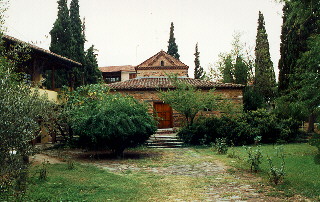 From there you follow the city walls little bit more until you reach the huge Chain Tower, from where again you have a good view over the city. Then you turn downhill through couple of more nice streets of Ano Poli to reach the tiny church of Agios Nicolaos Orfanos. This church is a very pleasant surprise. The fresco decorations are almost entirely preserved. It is located in a nice garden and it was built and painted in the beginning of the 14th century. Among other compositions, the miracles of Christ and the life of St. Nicolas are presented. The influence of Ohrid art school, presented through the work of Michael and Eutychie, is evident. As you exit Ano Poli going back to Agiou Dimitriou Street, you may stop for a moment to see the house in which Mustafa Kemal Ataturk, the first Turkish president, was born in 1881. From there you follow the city walls little bit more until you reach the huge Chain Tower, from where again you have a good view over the city. Then you turn downhill through couple of more nice streets of Ano Poli to reach the tiny church of Agios Nicolaos Orfanos. This church is a very pleasant surprise. The fresco decorations are almost entirely preserved. It is located in a nice garden and it was built and painted in the beginning of the 14th century. Among other compositions, the miracles of Christ and the life of St. Nicolas are presented. The influence of Ohrid art school, presented through the work of Michael and Eutychie, is evident. As you exit Ano Poli going back to Agiou Dimitriou Street, you may stop for a moment to see the house in which Mustafa Kemal Ataturk, the first Turkish president, was born in 1881.
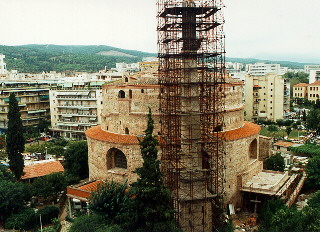 When you are back to the modern part of the city, you will soon reach the Rotunda. It was built in the beginning of the 4th century by the co-emperor of the Roman Empire Galerius Ceasar who made Thessaloniki his residence and imperial city. It is not known what the use of the building was at that time. Some say it was built as a Pantheon or Temple of Zeus, and many claim that it was built to serve as Mausoleum of Galerius. In any case, the building is majestic and has one of the most grandiose interiors you may have ever seen. The building is brick-built, circular in plan and covered by a huge dome. It was later turned into a church, by Theodosios the Great, and an apse was added to it. Towards the end of the 4th century, the interior was covered with beautiful golden mosaics of which some fragments still remain. They depict stylized decoration with different fruits and garlands of flowers. In 1591 the church was turned into a mosque and a minaret was added to it. Today it is a church again, dedicated to St. George. Around the Rotunda, you will also see many pieces of carved stones from the ancient, early christian and ottoman periods. When you are back to the modern part of the city, you will soon reach the Rotunda. It was built in the beginning of the 4th century by the co-emperor of the Roman Empire Galerius Ceasar who made Thessaloniki his residence and imperial city. It is not known what the use of the building was at that time. Some say it was built as a Pantheon or Temple of Zeus, and many claim that it was built to serve as Mausoleum of Galerius. In any case, the building is majestic and has one of the most grandiose interiors you may have ever seen. The building is brick-built, circular in plan and covered by a huge dome. It was later turned into a church, by Theodosios the Great, and an apse was added to it. Towards the end of the 4th century, the interior was covered with beautiful golden mosaics of which some fragments still remain. They depict stylized decoration with different fruits and garlands of flowers. In 1591 the church was turned into a mosque and a minaret was added to it. Today it is a church again, dedicated to St. George. Around the Rotunda, you will also see many pieces of carved stones from the ancient, early christian and ottoman periods.
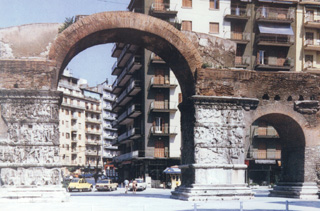 Your next stop will be the Arch of Galerius, the so called Kamara, just few steps away from the Rotunda. It used to be a three-arched gate, but today just two arches remain and it was built by Galerius in 305 to celebrate the victory over the Persians. A good portion of the marble carved reliefs have remained, depicting the great battle. Between the Rotunda and the Arch there are many cafés, mostly visited by students since the university is close by. You could take a break in one of them, of course with a nice view over the Arch. Right behind the Arch, there is the lovely 13th century church of Agios Panteleimon. Your next stop will be the Arch of Galerius, the so called Kamara, just few steps away from the Rotunda. It used to be a three-arched gate, but today just two arches remain and it was built by Galerius in 305 to celebrate the victory over the Persians. A good portion of the marble carved reliefs have remained, depicting the great battle. Between the Rotunda and the Arch there are many cafés, mostly visited by students since the university is close by. You could take a break in one of them, of course with a nice view over the Arch. Right behind the Arch, there is the lovely 13th century church of Agios Panteleimon.
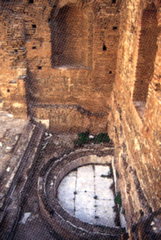
You should continue your walk towards the remains of the Palace of Galerius in Navarinou Square. While Diocletian was building for himself the impressive palace in Split, on the Dalmatian coast, his co-emperor Galerius built his own in Thessaloniki. It used to be a two-story building with a central open courtyard. The complex also includes a nymphaeum, a monumental basilica (used as a chamber for official audiences) and the Octagon. Most of the archaeologists think the Octagon may have been Galerius' throne room, because of the richly decorated multicolored marble floor. It is very sad that many of the present day buildings are built over the site of the palace and the archeological researches can't be carried out all the way. The Palace used to be attached to the Hippodrome where the chariot races used to take place in ancient times, but there is nothing left above ground of the structure.
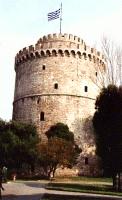 You will continue walking towards the sea until you reach the White Tower, the symbol of Thessaloniki. It was built as part of the city walls in the 16th century by the famous Ottoman architect Sinan. Many great intellectuals, revolutionaries and even ordinary people were imprisoned and died there when the Turks turned it into a prison and place of execution. There is a good bookstore in the tower and it is a lot of fun to climb it and enjoy the view from above. You will also find a wonderful collection of sculptures, frescoes, and other interesting artefacts from 300 to 1400 AD portraying the amazing history and culture of the city. You will continue walking towards the sea until you reach the White Tower, the symbol of Thessaloniki. It was built as part of the city walls in the 16th century by the famous Ottoman architect Sinan. Many great intellectuals, revolutionaries and even ordinary people were imprisoned and died there when the Turks turned it into a prison and place of execution. There is a good bookstore in the tower and it is a lot of fun to climb it and enjoy the view from above. You will also find a wonderful collection of sculptures, frescoes, and other interesting artefacts from 300 to 1400 AD portraying the amazing history and culture of the city.
If you still have the strength, you can continue the exploration of the city with a visit to the Museum of the Byzantine culture. This museum is something you should not miss, even if you are not very well acquainted with the Byzantine art. The exhibition is excellent and from room to room it tells the story on all aspects of the Byzantine civilization. The first room is dedicated to the Early Christian churches giving explanation of the architecture, wall and floor mosaics, fresco decoration and other different elements of the churches. The second is dedicated to the Early Christian cities and houses and it shows the urban structure, the economical life and the crafts as well as the residences and their equipment, even some dresses. The third is very interesting, showing the funerary traditions in the Early Christian period and finds from graves around Thessaloniki. Whole tombs are presented there with the complete fresco decoration preserved. Some exquisite jewellery found in the graves is also exhibited. The next set of rooms is dedicated to the Middle Byzantine period and the most interesting is the one showing the Byzantine castles and life in them, as well as some weapons and military tactics. The last part of the museum is titled the "Twilight of Byzantium" and covers the period between 1204 and 1453. This room shows a lot of treasures, but unfortunately not many icons from that period, and the ones exhibited don't have any particular artistic value. The highlight of the room is the liturgical cloth embroided with silver and golden strings. Finally, there are also a couple of more rooms in the museum showing post-byzantine, mostly 19th century icons.
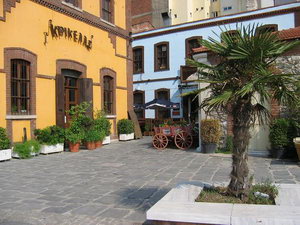 The Museum of Ancient Greek, Byzantine, and post-Byzantine Musical Instruments works until late and you may still have time to visit it. It is a private museum, owned by the Piraeus Bank located in the Ladadika area at the beginning of Tsimiski Str. On the three floors of the museum beautifully displayed reproductions of stringed and wind instruments are housed, many of which are recreated according to ancient vase paintings or Byzantine manuscripts and frescoes. Strolling through the museum is a lot of fun and it should not be missed. The Ladadika area is practically the only part of Thessaloniki's old Bazaar that has survived. All of the old stores and storage houses are now turned into restaurants, cafés and night clubs. The whole area is very well taken care of and you will certainly enjoy your time there. The Museum of Ancient Greek, Byzantine, and post-Byzantine Musical Instruments works until late and you may still have time to visit it. It is a private museum, owned by the Piraeus Bank located in the Ladadika area at the beginning of Tsimiski Str. On the three floors of the museum beautifully displayed reproductions of stringed and wind instruments are housed, many of which are recreated according to ancient vase paintings or Byzantine manuscripts and frescoes. Strolling through the museum is a lot of fun and it should not be missed. The Ladadika area is practically the only part of Thessaloniki's old Bazaar that has survived. All of the old stores and storage houses are now turned into restaurants, cafés and night clubs. The whole area is very well taken care of and you will certainly enjoy your time there.
Little bit of history
The city was founded in 315 BC by Kassandros, who named the city Thessaloniki after his wife, sister of Alexander the Great. In ancient times the city lived its greatest prosperity during the reign of the Roman emperor Galerius, who made Thessaloniki imperial city. During the Byzantine period, Thessaloniki became the second most important city of the empire and many beautiful churches were built. The Turks conquered the city in 1430 renaming it to Salonika. In 1492 many Jews settled in the city after being expelled from Spain. They made Thessaloniki the biggest trading centre of the Balkans. In 1900, over 80,000 Jews lived in the city representing the majority of the population. Unfortunately the Holocaust almost totally whiped them out and today there are just 1200 still living in Thessaloniki. The city has suffered from many disasters, the latest two being the great fire of 1917 and the earthquake of 1978, which have dramatically changed its outlook.
Couple of tips
The Byzantine heritage of the city is very rich, and there are many churches that deserve attention. Remember that from 1 PM to 5 PM usually most of the churches are closed. All of them are still active as churches and remember to be properly dressed when you visit them. The entrance to the churches and most of the monuments (like the Rotunda, the Roman Palace and the White Tower) is free. Do not miss the great cafés and clubs of Thessaloniki. Most of them are located on Aristotelous Square, along Nikis Street and in the Ladadika area.
Links
|
